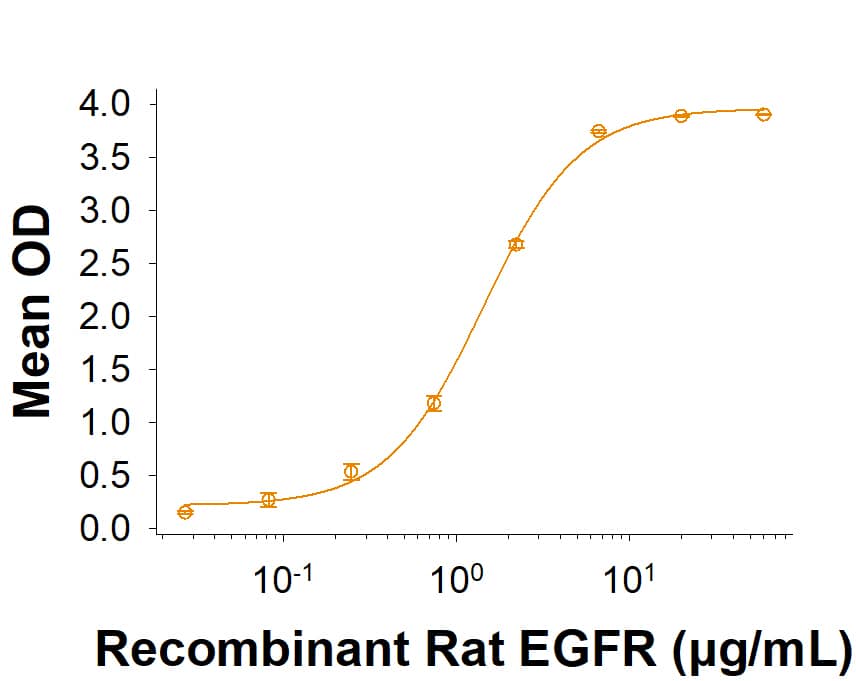Recombinant Rat EGFR His-tag Protein, CF Summary
Product Specifications
Leu25-Ile647, with a C-terminal 6-His tag
Analysis
Product Datasheets
11523-ER
Carrier Free
CF stands for Carrier Free (CF). We typically add Bovine Serum Albumin (BSA) as a carrier protein to our recombinant proteins. Adding a carrier protein enhances protein stability, increases shelf-life, and allows the recombinant protein to be stored at a more dilute concentration. The carrier free version does not contain BSA.
In general, we advise purchasing the recombinant protein with BSA for use in cell or tissue culture, or as an ELISA standard. In contrast, the carrier free protein is recommended for applications, in which the presence of BSA could interfere.
11523-ER
| Formulation | Lyophilized from a 0.2 μm filtered solution in PBS with Trehalose. |
| Reconstitution | Reconstitute at 500 μg/mL in PBS. |
| Shipping | The product is shipped at ambient temperature. Upon receipt, store it immediately at the temperature recommended below. |
| Stability & Storage: | Use a manual defrost freezer and avoid repeated freeze-thaw cycles.
|
Scientific Data
 View Larger
View Larger
Measured by its binding ability in a functional ELISA. Recombinant Rat EGFR His-tag Protein (Catalog # 11523-ER) binds to Recombinant Rat EGF Protein (3214-EG) with an ED50 of 0.750-7.50 μg/mL.
 View Larger
View Larger
2 μg/lane of Recombinant Rat EGFR His-tag Protein (Catalog # 11523-ER) was resolved with SDS-PAGE under reducing (R) and non-reducing (NR) conditions and visualized by Coomassie® Blue staining, showing bands at 95-115 kDa, under reducing conditions.
Background: EGFR
Epidermal growth factor receptor (EGFR) is a member of a subfamily of receptor tyrosine kinases comprised of four members: EGFR (also known as HER-1, ErbB1, or ErbB), ErbB2 (Neu, HER-2), ErbB3 (HER-3), and ErbB4 (HER-4). All family members are type I transmembrane glycoproteins with an extracellular domain (ECD) containing two cysteine-rich domains separated by a spacer region and a cytoplasmic domain containing a tyrosine kinase domain followed by multiple tyrosine autophosphorylation sites (1, 2). Several soluble isoforms lacking the intracellular domain are generated by alternate splicing (3, 4). The mature ECD of rat EGFR shares 89% and 95% amino acid sequence identity with human and mouse EGFR, respectively. EGFR binds a subset of the EGF family ligands, including EGF, amphiregulin, TGF-alpha, betacellulin, epiregulin, HB-EGF, and epigen (1, 2). Ligand binding induces EGFR homodimerization as well as heterodimerization with ErbB2, resulting in kinase activation, heterodimerization tyrosine phosphorylation and cell signaling (5‑7). EGFR can also be recruited to form heterodimers with the ligand‑activated ErbB3 or ErbB4. EGFR signaling regulates multiple biological functions including cell proliferation, differentiation, motility, and apoptosis (5-7). EGFR is overexpressed in a wide variety of tumors and is the target of several anti-cancer drugs (8).
- Singh, A.B. and R.C. Harris (2005) Cell. Signal. 17:1183.
- Shilo, B.Z. (2005) Development 132:4017.
- Guillaudeau, A. et al. (2012) PLoS One. 7:1.
- Reiter J.L. et al. (2001) Genomics 71:1.
- Freed, D.M. et al. (2017) Cell. 171:683.
- Burgess, A.W. et al. (2003) Mol. Cell 12:541.
- Faria, J.A. et al. (2016) BBRC. 478:39.
- Lee, C.K. et al. (2017) J. Thoracic Oncology. 12:403.
FAQs
No product specific FAQs exist for this product, however you may
View all Proteins and Enzyme FAQsReviews for Recombinant Rat EGFR His-tag Protein, CF
There are currently no reviews for this product. Be the first to review Recombinant Rat EGFR His-tag Protein, CF and earn rewards!
Have you used Recombinant Rat EGFR His-tag Protein, CF?
Submit a review and receive an Amazon gift card.
$25/€18/£15/$25CAN/¥75 Yuan/¥2500 Yen for a review with an image
$10/€7/£6/$10 CAD/¥70 Yuan/¥1110 Yen for a review without an image




